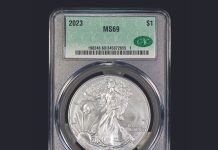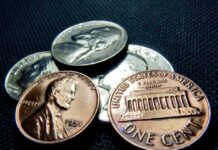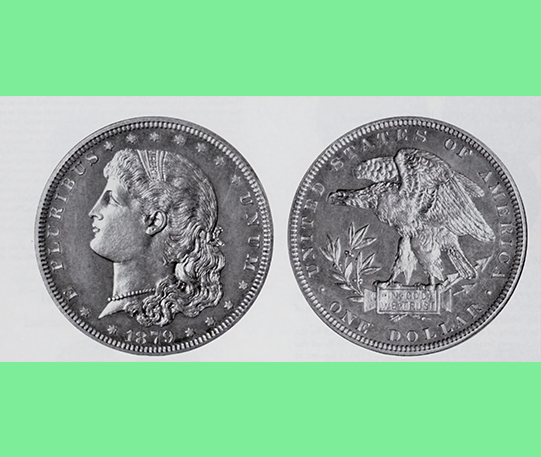
By Greg Reynolds
Editor’s Note: This is part two of the two-part series, “Global Turmoil and Coin Market History.” Enjoy Part I >>>
The economy of New York City was severely damaged by the terrorist attacks of September 11, 2001. As with the coronavirus, commercial real estate, hotels, convention activity, physical stores selling luxury goods, and restaurants were horridly harmed in an economic sense. Rather than a dream destination or host city, New York was thought of as a target after 09/11/01.
Many Wall Street firms opened or expanded offices in counties near New York City or other states so that their operations and employees would not be as exposed to terrorist attacks in the city. At the very least, during this time, New York was conjuring up negative issues in the minds of consumers, tourists, and business people. This opinion is similar to notions of conventions, business meetings, and public gatherings conjuring up negative images in people’s minds currently, during the era of the novel coronavirus.
Looking back on that tragic day in September 2001, I was on my way to New York City to attend a Stack’s auction. As I was traveling, I heard a comedian on the radio talk about terrorist attacks on New York City and the World Trade Centers “blowing up.” I thought that he was joking, as that comedian often did about serious topics. A few minutes later, this radio show was interrupted by a news update. It was said that only emergency personnel should come to Manhattan, the part of New York City where most business and tourist activity occurs. I then realized that awful events really happened. Like most people, I was shocked. Later, I realized that the auction I was planning to attend would be canceled or postponed.
I recall that fortunately, at that time, I had viewed lots for the auction the week before, which is similar to many who participated in the 2020 auction of the Pogue Collection. This sale in 2001 featured the collection of Cornelius Vermeule III, a famous researcher of ancient coins. Indeed, he had an impressive and noteworthy reputation as a museum curator and scholar. Curiously, he had some very important U.S. coins.
Vermeule had two very famous Morgan silver dollars. His Proof 1893-CC silver dollar is stunning. Spectrum-B&M auctioned a Proof 1893-CC that is probably the Vermeule coin in January 2005 for $132,250. A Proof 1893-CC, which is extremely likely to be the Vermeule coin, later appeared in three Stack’s Bowers auctions. It realized $149,500 in August 2011, $218,500 in August 2012, and did not sell in November 2013. I viewed lots for all these auctions.
Examining Bidder Response During Uncertainty
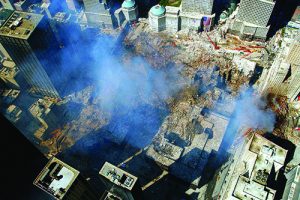
(BY CHIEF PHOTOGRAPHER’S MATE ERIC J. TILFORD, U.S. NAVY.)
An important point here is that the $63,250 result for the Vermeule 1893-CC Morgan in November 2001 was a strong price at the time. It would have been considered a retail price earlier in the year, weeks, or months before 9/11. My analyses suggest that there was a resurgence in coin collecting, starting in the mid to late 1990s, yet time was required for this resurgence to develop momentum. This resurgence in coin collecting and economic growth overall lead to sharply increasing prices for rarities from 2003 to the middle of 2008. The terrorist attacks of 09/11/01 did not have a significant effect one way or another.
As for the Stack’s auction set to occur on September 11 and 12, 2001, it was postponed until November, and there were additional opportunities to view the coins before they were auctioned.
The Vermeule 1893-S Morgan is one of the most famous of all silver dollars and currently is the most valuable Morgan dollar. The 1893-S is the key date business strike in the series of Morgan dollars. As I have explained in multiple published articles, the Vermeule 1893-S was the second finest Morgan silver dollar. The Norweb 1893-S was the finest until it was harmed while being ‘conserved.’ Consequently, the Vermeule 1893-S became the finest known.
The Vermeule 1893-S was auctioned for $414,000 in November 2001. It would have been auctioned on September 11, if the terrorist attacks had not occurred. Late in 2008, after rare coin markets dived in September, the Vermeule 1893-S traded privately for more than $1 million. From 2002 until the middle of 2008, values for many rare U.S. coins rose by more than 250%.
The immediate point is that there is no evidence that the terrorist attacks on 9/11 had a negative impact on the price realized for the Vermeule 1893-S on November 12, 2001. I repeat that rare coin markets were already in a trough before 9/11. Values do not seem to have been reduced further by the consequences of the terrorist attacks.
Many variables may relate to individual rare coins, specific auctions, and demand on any particular day or month. Market levels for rare coins may be fairly estimated by those who have the requisite knowledge of coins markets and are not too partial, but market levels cannot be precisely known. Even so, the market climate for rare coins and coin auctions late in 2001 is relevant to upcoming market levels and auctions in 2020 or 2021.
Most serious coin buyers have patience and are able to adjust. The Stack’s auction that was to occur on September 11 and 12, 2001 would have been followed by a Bowers & Merena auction in New York on September 14 and 15 at the Park Lane Hotel on Central Park South. Lot viewing sessions had been planned for the 13th and 14th. The event was rescheduled to be held in conjunction with the already planned Bowers & Merena auction in Baltimore late in November 2001.
The first major coin auction to be conducted after the terrorist attacks was the Dallas Bank sale by Sotheby’s, in association with Stack’s, on Dec. 29 and 30, 2001, at Sotheby’s headquarters in Manhattan. I was there and the sale was well attended. Although most of the people present lived in New York State or New Jersey, a large percentage of coin wholesalers in 2001 lived or had second homes in this area. There were also a few dealers from far away in the auction room, most notably Don Kagin from California.
Multiple Factors Influence Bidder Response
None of the Dallas Bank Collection coins had been submitted to PCGS or NGC, discouraged some collectors from participating, a point unrelated to the terrorist attacks of 09/11/01. During that era, Sotheby’s, Christie’s and Stack’s (N.Y.) did not usually send ‘old-time’ collections to PCGS or NGC. The ‘Dallas Bank’ collection is semi-legendary, and had been sitting in a bank vault in Dallas since the late 1970s.
The Dallas Bank Collection 1927-D Saint Gaudens double eagle ($20 gold
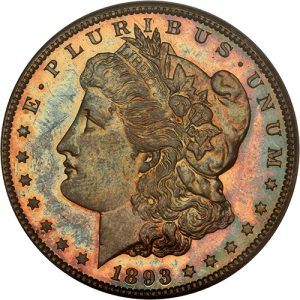
(STACKS BOWERS)
coin) brought $402,500. The 1927-D Saint is the rarest 20th-century business strike. The slightly inferior Duckor 1927-D indeed realized $577,500 in an auction by David Akers in May 1998. There is, though, an explanation for the $402,500 result that is unrelated to 9/11. That 1927-D Saint was auctioned a part of the Pittman II event. The John J. Pittman Collection was more important and drew far more attention than the Dallas Bank Collection.
Market levels for rare U.S. coins were more active from 1996 to early 1999 compared to late 1999 to late 2002. The latter period was relatively quiet, before and after the terrorist attacks of 9/11, which did not seem to make a significant difference.
Indeed, prices on average in the sale of the Dallas Bank Collection were in line with market levels before the terrorist attacks of 9/11. The $690,000 price realized for an Ultra High Relief 1907 Saint Gaudens double eagle pattern might not sound like much today. By 2008, each Ultra High Relief Saint was more than one million dollars. For this specific coin, however, this was a strong price in 2001.
The Ultra High Relief Saint that Bowers & Merena auctioned in January 1997 for $660,000 is of somewhat higher quality than the Dallas Bank piece. The Dallas Bank piece is one of the lower quality Ultra High Relief Saint patterns. They all dramatically increased in value from 2003 to 2008.
The Bowers & Merena sale that was postponed from the middle of September to November 28, 2001 featured many important patterns. One of the most famous and sought after of all is the Schoolgirl Dollar. Researcher Saul Teichman had traced fifteen different Schoolgirl dollars in silver and around a dozen in copper. All are dated 1879.
According to Teichman, the same Schoolgirl silver dollar that B&M auctioned on November 28, 2001, was earlier in the R.M. Fred Jr. Collection and other auctions between 1995 and 2002. This Schoolgirl dollar realized $39,600 in November 1995 as part of the Fred Collection, $41,400 in a Superior Galleries auction in June 1999, $48,875 in the already cited auction in 2001, and $43,700 in a Bowers & Merena auction on July 31, 2002, in New York. Is there a reason to believe that the terrorist attacks of 9/11 had a negative impact on any price realized for this Schoolgirl dollar?
Another interesting lot in this sale is a Proof 1868 half eagle ($5 gold coin). Like the just mentioned Schoolgirl dollar, this half eagle would have been auctioned on September 14 but was auctioned by Bowers & Merena on November 28, 2001. This 1868 was NGC certified as Proof-65 Ultra Cameo. It was earlier in the Bowers & Merena sale of the fourth part of the Harry Bass Collection in November 2000, in which it sold for $39,100. On November 28, 2001, it realized $42,550. Yes, its certification indeed changed in the interim, but it was in a PCGS holder and in one of the most famous gold coin collections of all time when it was auctioned in 2000.
While no one example proves a point, I have reflected upon a large number of auction results, and I was actively following coin auctions during this time. No one has had published more coin auction reviews than I have.
Examining Evidence To Determine Connections
Before and after 09/11/01, market levels for rarities were in a trough, but were gradually and just slightly trending upward, with light trading volume and some dips along the way. There is no solid evidence that the terrorist attacks negatively impacted market levels for rare U.S. coins.
Before and after the outbreak of the Coronavirus in 2020, market prices were trending downward, but, indeed, the consequences of the Coronavirus have dramatically reduced trading volume in rare and very scarce U.S. coins. While there is no clear evidence that interest in rare coins has been negatively impacted by the reactions to the spread of and policies relating to the Coronavirus, transactions have been impeded by government policies and fear.
Obviously, some people who were accustomed to traveling to buy coins have been buying fewer or zero coins due to government shutdowns and being discouraged from leaving home. It is not yet possible to tell if the underlying demand for rare coins will be affected over time by the strange events in 2020.
By 2005, the terrorist attacks of 9/11 were no longer at the forefront of people’s minds. New York City had recovered in an economic sense. Feelings of fear dropped to a minimal level.
Coin markets in the future will be exceptionally interesting.

